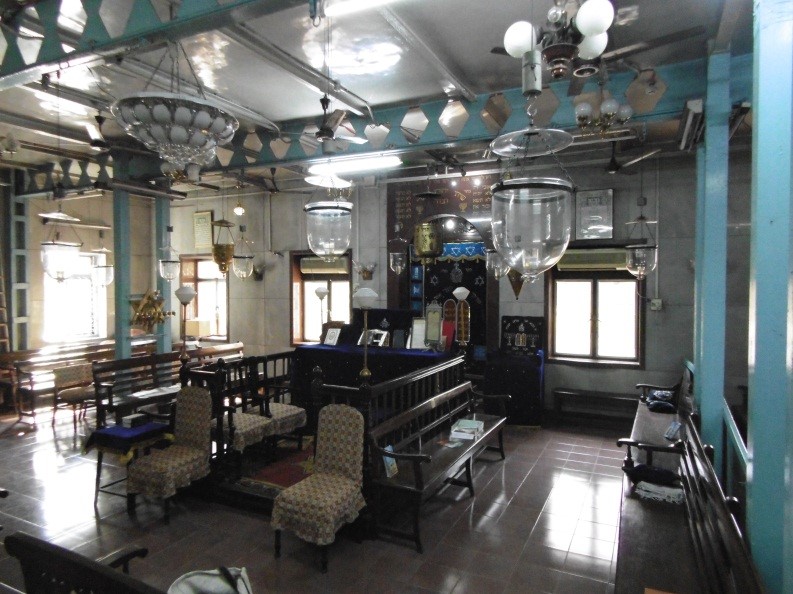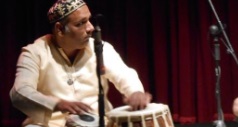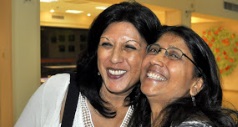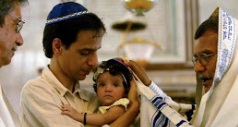TIPHERETH ISRAEL SYNAGOGUE (1924; altered and enlarged significantly over the years)
92, Keshavrao Khadye (K. K.) Marg (formerly Clarke Road)
Jacob Circle
(The synagogue is located on one of the ring roads just off Jacob Circle on the right side next to a school.)
Mumbai
Maharashtra, INDIA
This well-maintained and managed synagogue remains very active with even a growing congregation in recent years. Weekly Shabbat services and holiday services are held here. A synagogue manager, Mr. Aaron Kandlekar (telephone number "23053713") and a caretaker are regularly at the property, so guests should have little trouble visiting the building. Another synagogue number is "23083899". Guests are always invited to prayer services here. Like all Mumbai synagogues today, it is guarded by the Mumbai police.
Tiphereth Israel (Hebrew for Glory of Israel) was the third Bene Israel (Children of Israel) congregation to be organized in Mumbai. Jewish leaders, including Benjamin Samson Ashtamkar and Elijah Joseph Bhastekar, along with a group of friends formerly associated with an earlier synagogue, were responsible for establishing Tiphereth Israel as a prayer hall in 1886. Mumbai’s Bene Israel population grew during the mid-nineteenth century as the city prospered and expanded, and additional places for prayer and gathering to suit the needs of a varied and disperse community were needed. Initially the membership congregated in a rented space on the third floor of the Talegoaker Building in the Jacob’s Circle area of Mumbai (and very near this synagogue). Today this area has been absorbed into the vast metropolis, but in the late 1890s it was much less developed, even pastoral. What was originally known as Jacob Circle Prayer Hall became the most popular and prosperous of all Bene Israeli places of worship. In 1896, the prayer hall was renamed Tiphereth Israel.
By the early 1920s, three hundred Jewish families were living in and around Jacob Circle. To accommodate this sizeable group, a fundraising effort was begun for the purchase of their own building for religious and communal needs. On the 16th of March 1923, the acquisition of a bungalow named “Roshdel Villa” at 92, Keshavrao Khadye (formerly Clarke Road) near the post office took place. The wooden structure was bought from the Central Bank in a public auction in the amount of Rs. 35,600. A member of the congregation, Mr. Aaron Benjamin Kandlekar, had loaned a large sum towards this effort. On the 22nd of March 1923, this property was legally transferred in his name. By the following year, the existing property was repurposed into a synagogue, and on the 23rd of March 1924 it was consecrated a full synagogue (which generally refers to a larger facility offering more communal services and activities. In Kandlekar’s honor for his generosity, the synagogue also became known as Kandlekaranchi Masjid, or Kandlekar’s Synagogue. Kandlekar remained very engaged in the activities of the synagogue until his death in 1941.
In 1956, Kandlekar widow, Mrs. Elisheba transferred the ownership of the synagogue building from the Kandlekar Family to the Trustees of the Tiphereth Israel after accepting a part of the original loan amount. At the time this plaque was installed, a third generation of the Kandlekar Family was actively involved in the operation of this synagogue.
Throughout the 1930s, 40s, and into the 50s, Tiphereth Israel was a busy and vital center of Jewish spiritual and social life in Mumbai. A priority established by the congregation during those years involved children’s education, and in particular focusing on assisting poor Jewish pupils. Even though Tiphereth Israel was never a particularly wealthy synagogue, its members were devoted to charitable giving.
Tiphereth Israel Synagogue has been significantly altered and in cases essentially rebuilt over the years, so what can be seen today is very different from the building’s original early twentieth-century architecture. Of all the synagogues built over the years in Mumbai, this one has undergone the most transformations, including a major one in 2000. Under the leadership of architect Mrs. Sinora Mayer Penkar, who rendered her services free of charge, a community hall of 2,400 square feet was constructed on the first floor of the synagogue building. This large area, with its support spaces (a kitchen, dressing room, and storage area), replaced a smaller one built of wood. At the same time, the prayer hall’s heckal was renovated. Funds for this project were provided by the Indian Jewish community and other Jews living abroad.
The prayer hall interior, much changed over the years, is typical of most Bene Israel and other Indian synagogues with its centrally-placed wooden central tebah (bimah/raised reader’s platform with a table where the Torah is read and the service is conducted). The tebah is surrounded by a wood and brass balustrade. Casement windows, freestanding long wooden benches, and heckal (ark) set within a shallow niche that is positioned nearest Jerusalem as per synagogue convention also fit out the space. In the past, carved wooden screens supported by square wooden posts divided the rectangular prayer area into a larger central space and two smaller end sections. In more recent years, the sanctuary was changed to accommodate painted blue steel columns and beams to support and divide the space. The north end of the room has always served as the seating area for women as per Orthodox Jewish custom. Hanging brass and glass lanterns, ceiling fans, decorative metal window grilles, wall scones, framed Hebrew prayer verses hung on the painted chunam (plaster of polished lime and sand) walls, and colorful fabrics traditionally draping the tebah and heckal complete this space. The prayer hall space is paved with composition tiles. A special fixture seen in synagogues is the ner tamid, or light that always burns to indicate the presence of God. Fabricated from brass, it hangs in front of the heckal. A second special fixture, one for the prophet Elijah, is nearby. Also in the sanctuary are special draped groups near the heckal: one for the prophet Elijah, and the other for the brit mila, or circumcision ceremony.
A kosher mikvah (ritual bath) for ladies was constructed on the northeast side of the synagogue property, and it was inaugurated on the 22nd of January 2006. It was realized under the supervision of Rabbi Gabriel Holtzberg of Chabad.
As a result of social and political changes in India beginning in the 1950s, the country’s Bene Israel and other Jewish populations declined. Tiphereth Israel nevertheless today serves a small active and friendly Bene Israel congregation made up of men, women, and children of a variety of ages and backgrounds. They hold regular prayer services here as well as a variety of other religious and social events. In recent years, the synagogue has undergone resurgence with increased membership and activity. In late 2013, new Torah scrolls from Israel were donated by Mrs. Norin and Rabbi Romial Daniel of New York City, and its case was provided by Mr. Elirani Moshe Russo. Visitors from near and far are always welcome to attend and to contribute to the service conducted by members of the congregation.

Exterior

Interior








